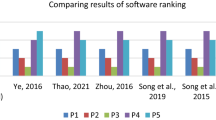Abstract
This study proposes a software quality evaluation model and its computing algorithm. Existing software quality evaluation models examine multiple characteristics and are characterized by factorial fuzziness. The relevant criteria of this model are derived from the international norm ISO. The main objective of this paper is to propose a novel Analytic Hierarchy Process (AHP) approach for addressing uncertainty and imprecision in service evaluation during pre-negotiation stages, where comparative judgments of decision makers are represented as fuzzy triangular numbers. A new fuzzy prioritization method, which derives crisp priorities from consistent and inconsistent fuzzy comparison matrices, is proposed. The Fuzzy Analytic Hierarchy Process (FAHP)-based decision-making method can provide decision makers or buyers with a valuable guideline for evaluating software quality. Importantly, the proposed model can aids users and developers in assessing software quality, making it highly applicable for academic and commercial purposes.



Similar content being viewed by others
References
Buckley, J. J. (1985). Fuzzy hierarchical analysis. Fuzzy Sets and Systems, 17, 233–247.
Cesar, G. P., Tom, M., & Brian, H. S. (2005). A metamodel for assessable software development methodologies. Software Quality Journal, 13(2), 195–214.
Deng, H. (1999). Multicriteria analysis with fuzzy pair-wise comparisons. International Journal of Approximate Reasoning, 21, 215–231.
Deutsch, M. S., & Wills, R. R. (1998). Software quality engineering; a total technical and management approach. Prentic-Hall, Inc.
ISO/IEC9126-1 (2001). Software engineering—product quality— part1: Quality model.
Issac, G., Rajendran, C., & Anantharaman, R. N. (2006). An instrument for the measurement of customer perceptions of quality management in the software industry: An empirical study in India. Software Quality Journal, 14(4), 291–308.
Kazman, R., Bass, L., Klein, M., Lattanze, T., & Northrop, L. (2005). A basis for analyzing software architecture analysis methods. Software Quality Journal, 13(4), 329–355.
Khoshgoftaar, T. M., Herzberg, A., & Seliya, N. (2006b). Resource oriented selection of rule-based classification models: An empirical case study. Software Quality Journal, 14(4), 309–338.
Khoshgoftaar, T. M., Seliya, N., & Sundaresh, N. (2006a). An empirical study of predicting software faults with case-based reasoning. Software Quality Journal, 14(2), 85–111.
Kima, S. S., Yang, I. O., Yeo, M. S., & Kim, K. W. (2005). Development of a housing performance evaluation model for multi-family residential buildings in Korea. Building and Environment, 40, 1103–1116.
Lious, T. S., & Wang, M. J. J. (1992). Ranking fuzzy numbers with integral value. Fuzzy Sets and Systems, 50(3), 247–255.
Liu, F., Noguchi, K., Dhungana, A., Srirangam, A. V. V. N. S. N., & Inuganti, P. (2006). A quantitative approach for setting technical targets based on impact analysis in software quality function deployment. Software Quality Journal, 14(2), 113–134.
Ngai, E. W. T (2003). Selection of web sits for online advertising using the AHP. Information and Management, 46, 669–678.
Ossadnik, W., & Lange, O. (1999). AHP-based evaluation of AHP-Software. European Journal of Operational Research, 118(2), 578–588.
Pressman, R. S. (2001). Software engineering a practitioner’s approach. Fifth Edition, McGraw Hill.
Rafla, T., Robillard, P. N., & Desmarais, M. C. (2007). A method to elicit architecturally sensitive usability requirements: its integration into a software development process. Software Quality Journal, 15(2), 117–133.
Saaty, T. L. (1980). The analytic hierarchy process. New York: McGraw Hill.
Saaty, T. L. (1988). Multicriteria decision making: The analytic hierarchy process. Pittsburgh: RWS Publications.
Saaty, T. L. (1990). How to mark a decision: The analytic hierarchy process. European Journal of Operational Research, 48(1), 9–26.
Schulmeyer, G. G., & McManus, J. I. (1996). Total quality management for software quality. Southern Africa: International Thomson Pub.
Word, W. A., & Venkataraman, B. (1999). Some observations on software quality. In Proceedings of the 37th annual Southeast regional conference, April 1999.
Zadeh, L. (1965). Fuzzy sets. Information Control, 8, 338–353.
Zhu, L., Aurum, A., Gorton, I., & Jeffery, R. (2005). Tradeoff and sensitivity analysis in software architecture evaluation using analytic hierarchy process. Software Quality Journal, 13(4), 357–375.
Author information
Authors and Affiliations
Corresponding author
Rights and permissions
About this article
Cite this article
Chang, CW., Wu, CR. & Lin, HL. Integrating fuzzy theory and hierarchy concepts to evaluate software quality. Software Qual J 16, 263–276 (2008). https://doi.org/10.1007/s11219-007-9035-2
Published:
Issue Date:
DOI: https://doi.org/10.1007/s11219-007-9035-2




